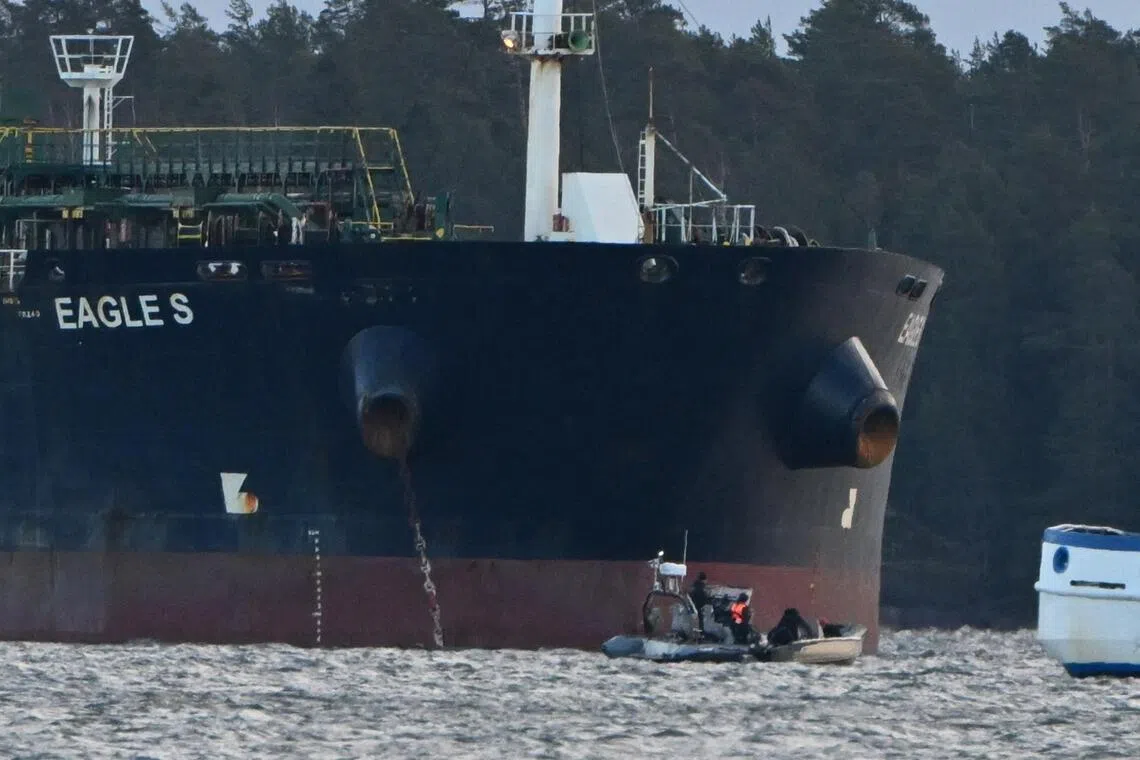Nato Baltic Sea mission has ‘deterred’ undersea sabotage, say commanders
Sign up now: Get ST's newsletters delivered to your inbox

Crew members of the Eagle S oil tanker - thought to be part of Russia’s “shadow fleet” of ships used to skirt western sanctions - were accused of dragging their anchor across the seabed in the Gulf of Finland in 2024, damaging cables.
PHOTO: AFP
Follow topic:
- Nato's Baltic Sentry mission successfully deterred threats to undersea infrastructure in the Baltic Sea since January 2024, following cable damage in December 2024.
- Protecting undersea cables is a "legal issue"; Commodore Warnaar highlighted difficulties in proving intent behind damage, as seen in the Eagle S tanker case.
- Finland and Sweden's Nato membership bolsters defence capabilities, particularly in anti-submarine warfare and managing drone incursions, according to commanders.
AI generated
LONDON - A Nato maritime mission to monitor the Baltic Sea
The hulking grey vessel – the flagship of one of Nato’s four permanent multinational fleets known as standing maritime groups – is docked in south-east London for a port visit, after months of conducting training exercises, including as part of the alliance’s Baltic Sentry patrol mission.
Baltic Sentry was pulled together in January to protect underwater infrastructure – thousands of kilometres of cables critical for global internet traffic – after five cables were severed
The Baltic Sea has become a flashpoint for tensions between Russia and Nato since Moscow’s 2022 invasion of Ukraine, worsened by its Baltic neighbours Finland and Sweden’s subsequent decision to join the alliance.
Military experts and European leaders say Russia has ramped up its “hybrid war” in the strategic region – now bordered entirely by Nato members, with the exception of Russia – through airspace incursions and suspected sabotage of undersea cables.
“But, since we started we haven’t seen any malign activity. There were quite a few incidents before,” said Commander Craig Raeburn, Chief of Staff of the Nato standing group that Johan de Witt belongs to.
“We have deterred that activity,” Comm Raeburn said from the command deck of the ship.
But according to the fleet’s leader, Commodore Arjen S. Warnaar, protecting undersea infrastructure in the Baltic is also a “legal issue” and those who damage it should be “held accountable”.
Crew members of the Cook Islands-registered Eagle S oil tanker, thought to be part of Russia’s “shadow fleet” of ships with dubious ownership used to skirt western sanctions, were accused of dragging their anchor across the seabed in the Gulf of Finland, damaging the cables.
Earlier this month, a Helsinki court dismissed the case for being beyond Finnish jurisdiction, which prosecutors said they will appeal.
“You can prove who did it, but can you prove if he did that on purpose? That’s much harder,” said Commodore Warnaar.
Nato commanders say defence capabilities in the region have been bolstered by Finland and Sweden’s expertise in protecting underwater infrastructure as well as in areas such as anti-submarine warfare and managing drone incursions.
“There’s a lot of effort done by the Baltic states,” said Commodore Warnaar.
“But we’re there. We’re looking. They know we’re looking. And that has an effect.” AFP

